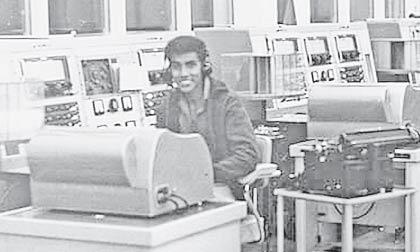ACCESS to information over the years has become increasingly efficient and effective thanks to the constantly evolving technology across the globe.
Communication has widely been regarded in the aviation industry as a cornerstone, the sector employing millions skilled in various facets of the profession.
By the 1960s, locals here at home had also begun to get a feel of how communications staff worked behind the scenes to keep the country’s airspaces up and running. And one of those men who dreamt of working as a communicator was Bobby Tikaram.
“When I was young and living in Lami, I used to see three or four people like Peter Miller, Johnny Kush, Ahmad Ali, Ernest Dutta going past our shop in the morning and returning in the afternoon on bicycles,” the 75-year-old says.
“I later found out they were among the first batch of communication cadets and were training as communicators at the training school where Novotel hotel is today in Lami.
“When I joined in 1964 (by that time the communication training school had moved to Nadi Airport), I was surprised to see them as my seniors in the communication section.” Mr Tikaram qualified as a communicator in 1965, and was later promoted to senior communicator, air ground officer and then communication supervisor and retired as acting senior communication supervisor in 2001.
Having spent 37 years in the industry, he says the purpose of communication is to provide detailed flight and weather reports to and from other Pacific Island nations.
This was done via morse code. A tactic which has been deemed obsolete as newer technologies line up communications stations today, Morse code was at its time the most effective means of communicating.
To some extent, it still is today.
“Basically, we received and sent flight plans to and from other Pacific Island stations, airlines, Nadi Forecasting Centre and authorities concerned via morse code and torn tape relay, along with providing voice communication (air/ground) to and with all flights within the Nadi Flight Information Region.
“Morse code and torn tape is now obsolete with voice communication phasing out with direct link to and from aircraft.” His superior and long-term colleague, Hussein Samat, says this was the case since 1954.
“Gradually, as communications links improved, we changed to radio, and landline,” Mr Samat said.
“FINTEL used to provide landline link and we operated on radio and then as everything improved, the system of communicating changed and then we got computerised. It’s all emails and smartphones now.”
Not itself an easy skill to master, learning morse code was a crucial part of training young communicators back in the day.
In fact, Mr Samat said this was deemed mandatory and only the brightest of students, selected by the South Pacific Air Transport Council (SPATC), were trained.
The council still managed Nadi airport at the time.
“We had to undertake one-year training at what they called the SPATC Communicator Training School based at Nadi Airport, exactly where the Civil Aviation Authority of Fiji (CAAF) headquarters is now.
“One side of the building was dorms and the training school was on the other. I think they started from 1962, I don’t have the exact numbers.
“I do know there were about three people who were trained in 1963, then five people in 1964 and by 1965, there was a rapid localisation going and they started training locals as communicators and technicians, as air traffic controllers.
“So we did our one-year training and then we moved on to what they called ‘on the job’ training.”
Once you moved past this, the trainees were given six-hour shift work.
“Once you had learnt all the aspects of what you are supposed to do, then you started doing shift work. Our place was actually called Nadi Communications Centre, which is the current domestic terminal at Nadi airport, so some of us moved on to air traffi ccontrol and technicians.”
While the experience was quite new and exciting for the new trainees, it wasn’t without facing challenges.
“The only problem would have been if you tried to establish communications between Nadi and Tahiti, it was a long distance so you had to try and tune in to the right frequency so you could communicate efficiently.
“If you don’t have the right connections, you could not do so. Shift work was always challenging.”
Localisation helped improve the skill sets of these budding communicators and after control was handed over to the Fijian Government, their knowledge and experience came in handy.
Mr Samat said a majority of personnel worked their way up the ladder from being communicators to senior communicators,air ground operator — a position where they communicated to aircraft within the Flight Information Region — and eventually moving to a supervisory role and later, management positions.
- Next week: We move on to our national airline Fiji Airways. Read more about the company’s founder Harold Gatty and his work in Fiji




